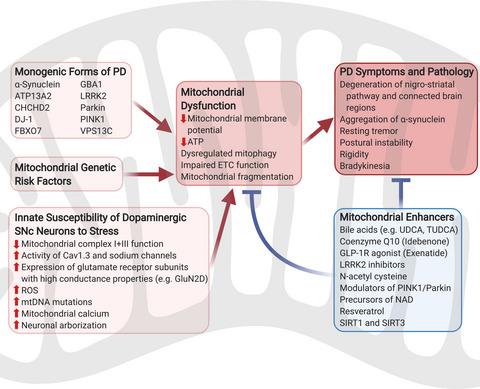当前位置:
X-MOL 学术
›
J. Neurochem.
›
论文详情
Our official English website, www.x-mol.net, welcomes your
feedback! (Note: you will need to create a separate account there.)
The multi‐faceted role of mitochondria in the pathology of Parkinson’s disease
Journal of Neurochemistry ( IF 4 ) Pub Date : 2020-08-16 , DOI: 10.1111/jnc.15154 Dennison Trinh , Ahmad R. Israwi , Lindsay R. Arathoon , Jacqueline A. Gleave , Joanne E. Nash
Journal of Neurochemistry ( IF 4 ) Pub Date : 2020-08-16 , DOI: 10.1111/jnc.15154 Dennison Trinh , Ahmad R. Israwi , Lindsay R. Arathoon , Jacqueline A. Gleave , Joanne E. Nash

|
Mitochondria are essential for neuronal function. They produce ATP to meet energy demands, regulate homeostasis of ion levels such as calcium and regulate reactive oxygen species that cause oxidative cellular stress. Mitochondria have also been shown to regulate protein synthesis within themselves, as well as within the nucleus, and also influence synaptic plasticity. These roles are especially important for neurons, which have higher energy demands and greater susceptibility to stress. Dysfunction of mitochondria has been associated with several neurodegenerative diseases, including Parkinson's disease, Alzheimer's disease, Huntington's disease, Glaucoma and Amyotrophic Lateral Sclerosis. The focus of this review is on how and why mitochondrial function is linked to the pathology of Parkinson's disease (PD). Many of the PD‐linked genetic mutations which have been identified result in dysfunctional mitochondria, through a wide‐spread number of mechanisms. In this review, we describe how susceptible neurons are predisposed to be vulnerable to the toxic events that occur during the neurodegenerative process of PD, and how mitochondria are central to these pathways. We also discuss ways in which proteins linked with familial PD control mitochondrial function, both physiologically and pathologically, along with their implications in genome‐wide association studies and risk assessment. Finally, we review potential strategies for disease modification through mitochondrial enhancement. Ultimately, agents capable of both improving and/or restoring mitochondrial function, either alone, or in conjunction with other disease‐modifying agents may halt or slow the progression of neurodegeneration in Parkinson's disease.
中文翻译:

线粒体在帕金森氏病病理学中的多方面作用
线粒体对于神经元功能至关重要。它们产生ATP以满足能量需求,调节钙等离子水平的稳态,并调节引起氧化性细胞应激的活性氧。线粒体还被证明可以调节自身以及细胞核内的蛋白质合成,并且还影响突触的可塑性。这些作用对于神经元特别重要,神经元具有更高的能量需求和更大的压力承受能力。线粒体功能障碍与几种神经退行性疾病有关,包括帕金森氏病,阿尔茨海默氏病,亨廷顿氏病,青光眼和肌萎缩性侧索硬化症。这篇综述的重点是线粒体功能如何以及为什么与帕金森氏病(PD)的病理联系在一起。通过广泛的机制,已经发现的许多与PD相关的遗传突变导致线粒体功能异常。在这篇综述中,我们描述了易感性神经元如何易受PD神经退行性过程中发生的毒性事件的影响,以及线粒体如何成为这些途径的核心。我们还将讨论与家族性PD相关的蛋白质在生理和病理上控制线粒体功能的方式,以及它们在全基因组关联研究和风险评估中的意义。最后,我们回顾了通过线粒体增强进行疾病修饰的潜在策略。最终,能够单独改善和/或恢复线粒体功能的药物,
更新日期:2020-08-16
中文翻译:

线粒体在帕金森氏病病理学中的多方面作用
线粒体对于神经元功能至关重要。它们产生ATP以满足能量需求,调节钙等离子水平的稳态,并调节引起氧化性细胞应激的活性氧。线粒体还被证明可以调节自身以及细胞核内的蛋白质合成,并且还影响突触的可塑性。这些作用对于神经元特别重要,神经元具有更高的能量需求和更大的压力承受能力。线粒体功能障碍与几种神经退行性疾病有关,包括帕金森氏病,阿尔茨海默氏病,亨廷顿氏病,青光眼和肌萎缩性侧索硬化症。这篇综述的重点是线粒体功能如何以及为什么与帕金森氏病(PD)的病理联系在一起。通过广泛的机制,已经发现的许多与PD相关的遗传突变导致线粒体功能异常。在这篇综述中,我们描述了易感性神经元如何易受PD神经退行性过程中发生的毒性事件的影响,以及线粒体如何成为这些途径的核心。我们还将讨论与家族性PD相关的蛋白质在生理和病理上控制线粒体功能的方式,以及它们在全基因组关联研究和风险评估中的意义。最后,我们回顾了通过线粒体增强进行疾病修饰的潜在策略。最终,能够单独改善和/或恢复线粒体功能的药物,























































 京公网安备 11010802027423号
京公网安备 11010802027423号